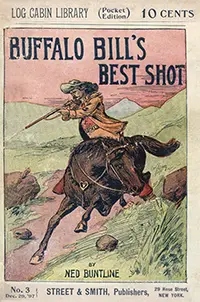William "Buffalo Bill" Cody was one of the most famous Americans of the late 19th Century. A sharpshooter, skilled outdoorsman, and overall magnetic personality, he was most well-known for his traveling Wild West Show, which played hundreds and hundreds of shows in the U.S. and Europe for 30 years. 
He was born on Feb. 26, 1846, near LeClaire, Iowa.The family moved to Leavenworth, Kan., in 1853. His father, Isaac, was outspoken in his opposition to slavery, and this put him at odds with many in Kansas (where such confrontations turned violent so often that the territory became known as "Bleeding Kansas"). On one occasion, young William learned of an assassination plot against his father and rode 30 miles from home to warn him. Isaac Cody had already sustained a stabbing after giving a passionate antislavery speech; he became ill, the stab wound got infected, and he died, when young William was 11. William responded by going to work. When he was 12, he found work on a wagon train bound for Fort Laramie, Wyo. Two years later, he joined the Colorado gold rush but found little success. When he was 15, he was a rider on the Pony Express. Cody served in the Civil War, as a cavalry scout for the Union Army. He saw action in Missouri in Tennessee and, after the war, continued to serve, based in Fort Ellsworth, Kan. He married Louisa Frederici on March 6, 1866; they had four children together. 
He earned his famous nickname when he was working on the Kansas Pacific Railroad, bagging buffaloes with his excellent aim with a gun. His own total in 17 months of operation was 4,280. Another famous William, Bill Comstock, also had a reputation as a buffalo hunter and also wanted the nickname "Buffalo Bill." The two agreed to have a shooting match to decide who had exclusive rights to the name; in the ensuing competition, Cody show 68 buffalo and Comstock just 48. Cody served again with the Army, this time as a civilian, filling the role of scout and guide. He won the Congressional Medal of Honor in 1872. It was the U.S. Army General Philip Sheridan who first employed Cody as a guide for visiting dignitaries. Cody, along with Major Gen. George Armstrong Custer, showcased the American West while also showing Grand Duke Alexis of Russia and other famous foreign leaders around on nominal hunting expeditions. 
Cody featured in a series of magazines, gaining him a bit of fame. In 1872, Cody took the advice of the writer Ned Buntline and played himself in a stage show that Buntline wrote titled The Scouts of the Plains. Buntline had earlier written the novel Buffalo Bill, King of the Bordermen, which had been very successful. Cody found that he liked the limelight and the very next year formed his own traveling company, which also included another famous Westerner, James Butler "Wild Bill" Hickok. Cody also did his own writing, publishing his autobiography in 1879 and writing his own dime novels, in the manner of Buntline, his inspiration. Conflict between American settlers and Native American tribes heightened during the 1870s, and Cody went back into the Army, serving as a scout. On July 17, 1876, Cody and a number of other soldiers encountered a group of Cheyenne warriors. In the violent exchange, Cody killed the Cheyenne chief Yellow Hair and declared it revenge for Custer (who, along with all of his men, had died in the Battle of Little Big Horn a few weeks earlier). The height of Cody's performance career began in 1883, when he launched Buffalo Bill's Wild West, a traveling show that played to large and appreciative crowds for 30 years around the U.S. and in several countries in Europe. Among the other famous members of this troupe were Annie Oakley, the famous female sharpshooter; Buck Taylor, the "King of the Cowboys"; and the famous Native American warriors Geronimo and Sitting Bull. Among the elaborate stage presentations that audiences routinely saw were dramatizations of stagecoach robberies, a buffalo hunt (which featured real buffalo), a Native American attack (featuring Native Americans), and a re-enactment of Custer's Last Stand (which, for one season, included Sitting Bull, who had played a part in Custer's demise). 
In 1887, Cody's Wild West show went to London, as part of the American Exhibition, which took place alongside the Golden Jubilee of Queen Victoria. The Prince of Wales got a private performance and enjoyed it so much that he convinced Cody to do another private performance, for the queen. Queen Victoria was so impressed that she requested another performance, which was attended by a number of other European dignitaries, including Germany's Kaiser Wilhelm II. On a subsequent European tour, the troupe met Pope Leo XIII. The troupe performed in most countries in Europe during the next several years. Cody took a lot of the money that he earned from his Wild West shows and invested it into other businesses, including a mine in Arizona, a hotel in the Wyoming towns of Cody and Sheridan, and various ranches and coal and oil enterprises. He even began his own newspaper, the Cody Enterprise, in 1899. He was instrumental in the founding of the Wyoming town named after him, Cody. The town, incorporated in 1901, had streets named after people with whom he had worked. Cody was one of the most famous Americans to have lived in the late 19th Century and early 20th Century. To a great many people, he symbolized the romantic image of the American West. He was an unofficial advisor to a series of U.S. Presidents. Among his friends were the author Mark Twain and the painter Frederic Remington. In later years, he campaign for fair treatment of Native Americans and for more rights for women. He died on Jan. 10, 1917 and is buried at the summit of Colorado's Lookout Mountain. |
|
Social Studies for Kids
copyright 2002–2024
David White




